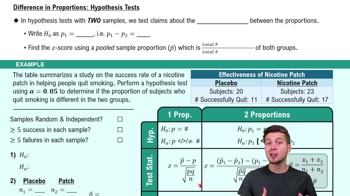37. Water Pollution An environmental agency is analyzing water samples from 80 lakes for pollution. Five of the lakes have dangerously high levels of dioxin. Six lakes are randomly selected from the sample. Use technology to find how many ways one polluted lake and five nonpolluted lakes can be chosen.
Table of contents
- 1. Intro to Stats and Collecting Data1h 14m
- 2. Describing Data with Tables and Graphs1h 55m
- 3. Describing Data Numerically2h 5m
- 4. Probability2h 16m
- 5. Binomial Distribution & Discrete Random Variables3h 6m
- 6. Normal Distribution and Continuous Random Variables2h 11m
- 7. Sampling Distributions & Confidence Intervals: Mean3h 23m
- Sampling Distribution of the Sample Mean and Central Limit Theorem19m
- Distribution of Sample Mean - Excel23m
- Introduction to Confidence Intervals15m
- Confidence Intervals for Population Mean1h 18m
- Determining the Minimum Sample Size Required12m
- Finding Probabilities and T Critical Values - Excel28m
- Confidence Intervals for Population Means - Excel25m
- 8. Sampling Distributions & Confidence Intervals: Proportion1h 12m
- 9. Hypothesis Testing for One Sample3h 29m
- 10. Hypothesis Testing for Two Samples4h 50m
- Two Proportions1h 13m
- Two Proportions Hypothesis Test - Excel28m
- Two Means - Unknown, Unequal Variance1h 3m
- Two Means - Unknown Variances Hypothesis Test - Excel12m
- Two Means - Unknown, Equal Variance15m
- Two Means - Unknown, Equal Variances Hypothesis Test - Excel9m
- Two Means - Known Variance12m
- Two Means - Sigma Known Hypothesis Test - Excel21m
- Two Means - Matched Pairs (Dependent Samples)42m
- Matched Pairs Hypothesis Test - Excel12m
- 11. Correlation1h 6m
- 12. Regression1h 50m
- 13. Chi-Square Tests & Goodness of Fit1h 57m
- 14. ANOVA1h 57m
4. Probability
Counting
Problem 3.4.50d
Textbook Question
50. Investment Committee A company has 200 employees, consisting of 144 women and 56 men. The company wants to select five employees to serve as an investment committee.
d. Explain how the company can select a representative sample of the male and female population of employees.
 Verified step by step guidance
Verified step by step guidance1
Step 1: Understand the problem. The company wants to select a representative sample of 5 employees from a population of 200 employees, consisting of 144 women and 56 men. A representative sample means the proportion of men and women in the sample should reflect the proportions in the population.
Step 2: Calculate the proportion of women and men in the population. The proportion of women is given by dividing the number of women by the total number of employees: \( \text{Proportion of women} = \frac{144}{200} \). Similarly, calculate the proportion of men: \( \text{Proportion of men} = \frac{56}{200} \).
Step 3: Determine the number of women and men to include in the sample. Multiply the total sample size (5) by the proportion of women to find the number of women to include: \( \text{Number of women in sample} = 5 \times \frac{144}{200} \). Similarly, calculate the number of men to include: \( \text{Number of men in sample} = 5 \times \frac{56}{200} \).
Step 4: Round the results from Step 3 to the nearest whole numbers, ensuring the total adds up to 5. For example, if the calculations yield 3.6 women and 1.4 men, round to 4 women and 1 man, as this maintains the total sample size of 5.
Step 5: Use a random sampling method to select the specific individuals. For women, randomly select the calculated number of women (e.g., 4) from the 144 women. For men, randomly select the calculated number of men (e.g., 1) from the 56 men. This ensures the sample is both random and representative of the population proportions.
 Verified video answer for a similar problem:
Verified video answer for a similar problem:This video solution was recommended by our tutors as helpful for the problem above
Video duration:
6mPlay a video:
Was this helpful?
Key Concepts
Here are the essential concepts you must grasp in order to answer the question correctly.
Sampling Methods
Sampling methods are techniques used to select individuals from a population to participate in a study. Common methods include random sampling, stratified sampling, and systematic sampling. In this context, the company can use stratified sampling to ensure that both men and women are represented proportionally in the selection of the investment committee.
Recommended video:

Sampling Distribution of Sample Proportion
Proportional Representation
Proportional representation refers to the practice of ensuring that different subgroups within a population are represented in the sample in the same proportion as they exist in the population. For the company, this means selecting committee members in a way that reflects the ratio of women to men among the employees, which is 72% women and 28% men.
Recommended video:
Guided course

Difference in Proportions: Hypothesis Tests
Sample Size
Sample size is the number of individuals selected from a population for a study. It is crucial to determine an appropriate sample size to ensure that the sample accurately reflects the population. In this case, the company needs to decide how many men and women to select from the total of five committee members to maintain the proportional representation of the employee demographics.
Recommended video:

Sampling Distribution of Sample Proportion

 7:11m
7:11mWatch next
Master Introduction to Permutations with a bite sized video explanation from Patrick
Start learningRelated Videos
Related Practice
Textbook Question
